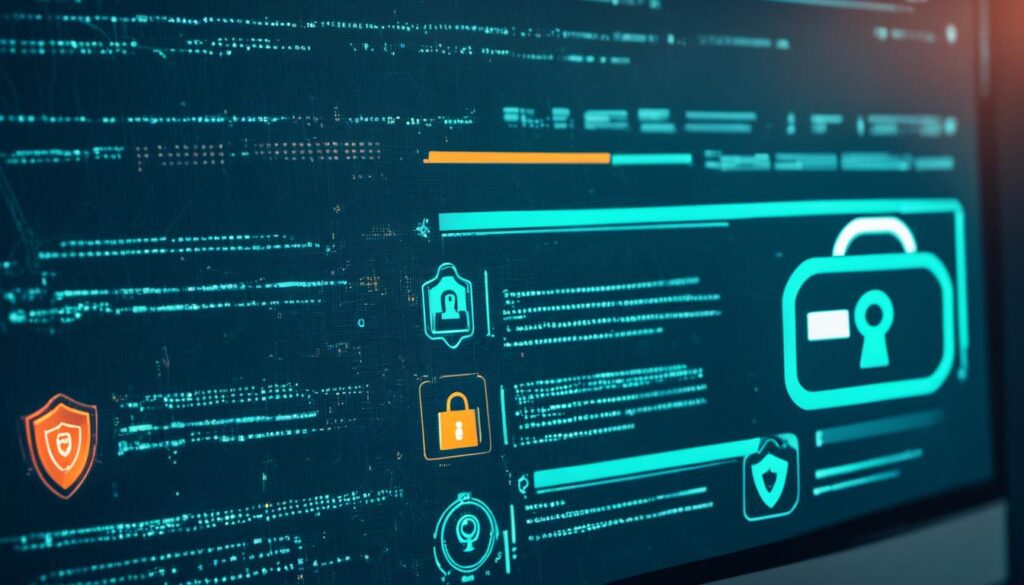Did you know that a single code signing certificate breach can potentially put millions of users at risk? Secure code validation, implemented through Public Key Infrastructure (PKI) and authorized by a respected digital certificate authority, is an essential component in maintaining the security and trustworthiness of countless applications. This technology not only fortifies the software we rely on daily but also ensures a publisher’s digital identity is verifiable through robust digital signature software.
Digital certificates are akin to a digital passport for applications; they unequivocally affirm the source and safeguard the code’s integrity from creation to deployment. Without this authentication, software distribution would be akin to a field without fences—open to any alterations by malicious actors, which could lead to disastrous consequences. As more of our critical infrastructures and personal routines become dependent on software, understanding PKI and code signing certificates is more than prudent—it is indispensable.
Key Takeaways
- Code signing certificates are a powerful guard against unauthorized tampering with software.
- PKI encompasses the roles of infrastructure, encryption, and verification for secure communication.
- A digital certificate authority ensures the legitimacy and trustworthiness of code distributors.
- Digital signature software plays a pivotal role in maintaining user trust and software hygiene.
- The effectiveness of secure code validation is vital for the safety of millions of software users worldwide.
What Are PKI and Code Signing Certificates?
The digital world is increasingly reliant on mechanisms that can establish secure transactions and verify the identity of sources over the internet. To understand how this security is achieved, it’s essential to delve into the realms of Public Key Infrastructure (PKI) and code signing certificates. These components are crucial to cryptographic key management, ensuring that communication and data sharing across networks are secure against various threats.
Defining Public Key Infrastructure (PKI)
At its core, Public Key Infrastructure (PKI) is a set of roles, policies, hardware, software, and procedures needed to create, manage, distribute, use, store, and revoke digital certificates. The infrastructure enables secure electronic transfer of information for a range of activities such as e-commerce, internet banking, and confidential email. It uses a mathematical technique called public-key cryptography to facilitate critical functions, including authentication, digital signature, and encryption.
The Role of Code Signing Certificates in Software Security
Code signing certificates serve a pivotal role in bolstering software security. By attaching a digital signature to code, scripts, and software programs, these certificates ensure the authenticity and integrity of the distributed files. Users can trust that the software they download and run on their systems is tamper-proof and exactly as the developer intended, because an established Certificate Authority has vouchsafed for its legitimacy. This aspect of SSL certificate issuance is an indispensable part of maintaining a trustworthy digital environment.
Key Components of PKI Systems
The backbone of PKI lies in its ability to provide public key infrastructure services, which is facilitated by several key components that form a robust framework for cryptographic key management. These components not only support encryption and digital signatures but also enable the issuing, renewing, and revoking of SSL certificates. A closer look at each element reveals its unique role in securing digital communications.
One of the strengths of PKI is its versatility in addressing the broad spectrum of security challenges that arise in diverse technological landscapes. For clarity, let’s examine the components that make up an effective PKI system:
| Component | Function | Significance |
|---|---|---|
| Certificate Authority (CA) | Issue digital certificates to entities after proper validation. | Acts as a trusted third party, essential for establishing digital trust. |
| Registration Authority (RA) | Assists the CA in the verification process. | Ensures accuracy and authenticity in certificate issuance. |
| Certificates | Provide a digital passport for entities to prove their identity. | Forms the basis of trust and secure communications in the digital space. |
| Keys | Public-private key pairs used for encryption and decryption. | Enables confidentiality, data integrity, and non-repudiation. |
| Hardware Security Modules (HSMs) | Provide secure storage and generation of key pairs. | Protects private keys from unauthorized access, crucial for key management. |
Understanding these components and how they interact within the PKI framework provides insight into the complex yet necessary process of securing our digital world.
How Do PKI and Code Signing Certificates Enhance Security?
The advent of public key infrastructure (PKI) and code signing certificates has brought a paradigm shift in how digital security is perceived and implemented. As foundations of secure data protection solutions, these technologies blend cryptographic security mechanisms with identity validation to create a more trustworthy digital ecosystem. Not only do they facilitate encrypted communication tools, but they also vouch for the authenticity and integrity of software applications.

An essential role of PKI is to establish a framework that any digital platform or user can rely upon for secure interactions. PKI and code signing certificates collectively ensure that every piece of digital data is securely locked and delivered to its intended recipient without tampering or unauthorized access. Let’s decrypt how these security marvels achieve this feat.
- Data Integrity: Code signing certificates ensure that a piece of software, once signed by a legitimate certificate, remains untampered and unaltered. Any modification invalidated the signature, alerting the user.
- Authentication: PKI’s secure encryption protocols verify the credentials of a digital entity, assuring users that the application or message they are interacting with is from a reliable and verified source.
- Non-repudiation: Once a developer signs a code, they cannot deny publishing it. This creates a layer of accountability and trust in digital transactions.
Below is a comparative table that outlines how PKI and code signing certificates contribute to creating secure environments, essential for maintaining privacy and security in our interconnected world.
| Security Aspect | Contribution of PKI | Contribution of Code Signing Certificates |
|---|---|---|
| Validation and Trust | Establishes trust between entities through certificate-based identification. | Validates software’s source and integrity, ensuring the code stems from a legitimate entity. |
| Secure Communications | Encrypts data exchanges, guarding against eavesdropping and data breaches. | Code integrity checks prevent executable files from becoming a vector for malware. |
| Identity Verification | Manages digital certificates that tie digital entities to cryptographic key pairs. | Confirms the identity of software publishers, giving users confidence in installation. |
| Document Security | Enables signing of electronic documents to confirm the sender’s identity and intent. | Applies a unique digital signature to code, analogous to a tamper-proof seal on software. |
As we delve deeper into a digital-first world, the credentials provided by secure data protection solutions become inseparable from our daily operations. From securing emails to safeguarding the installation of applications on our devices, PKI and code signing certificates continue to serve as vigilant custodians of data integrity and privacy.
The Mechanisms Behind Code Signing
Code signing represents a vital process in the world of software distribution, ensuring that each piece of code can be trusted by the end user. An essential element of this trust is established through a certificate management system, which is responsible for the issuance and verification of digital signatures. A signature affixed to software indicates that the content is secure and untampered, fostering secure code validation. Let’s delve into the components that make this possible.
Creating and Managing Digital Signatures
When a developer is ready to release their software, they must sign their work with a unique digital signature. This process involves generating a cryptographic hash of the code and then encrypting this hash with the developer’s private key. Once this digital signature is appended to the software, the certificate management system records and manages it, effectively sealing the code and preparing it for secure distribution.
Effective certificate management is not just about creating signatures; it’s the backbone of software security in code signing, overseeing the entire lifecycle of the digital certificate.
Verifying Authenticity and Integrity of Code
At the receiving end, the end users—or their devices—must verify the signed code’s authenticity and integrity. This is where the public key comes into play. It allows users to decrypt the signature, perform a hash function, and compare it to the hash of the downloaded code. If these hashes match, it assures the receiver that the software is genuine and has not been altered since it was signed—validating the software’s security and integrity.

Not only does this mechanism prevent tampering and unauthorized modifications to the software, but it also reinforces trust between developers and their audience. When a developer uses a reputable certificate management system, it strengthens their credibility within the market, signaling to users that their download is safe to execute and free from hidden malware or exploits—a cornerstone of secure code validation.
In the age where digital security is imperative, the role of robust code signing mechanisms cannot be understated. By understanding the intricate process of signing and validating code, both developers and users can ensure a safer digital environment for all.
Key Players in PKI: Certificate Authorities and Trustworthiness
The integrity of any Public Key Infrastructure (PKI) is heavily reliant on the role of digital certificate authorities. These institutions are not merely service providers; they are the cornerstone of secure digital interactions and are integral to the framework that binds identities to certificate holders. The trust placed in these certificate authorities is tantamount to the trust users place in the security of their online transactions.
As critical enablers of secure communication, certificate authorities undertake the substantial responsibility of not just issuing but also managing the lifecycle of digital certificates through a robust certificate management system. Their commitment to upholding stringent validation processes before issuing certificates is what affords the CAs their reputable status.
The authority and reliability of certificate authorities underpin the trustworthiness of digital signatures and secure data transactions.
- Validation of Identity – Ensuring that each certificate request comes from a legitimate entity before issuance.
- Issuance of Certificates – Granting validated entities with a digital certificate that verifies their identity online.
- Revocation Lists – Maintaining and updating lists of revoked certificates, which is essential for trust maintenance.
- Renewals and Expiry Checks – Managing the timely renewal and expiration of digital certificates.
By leveraging a mature certificate management system, CAs effectively mitigate the risks related to the misuse or misrepresentation of identities in the digital sphere. This systemic rigor is essential for the overall credibility of secure digital communications and transactions.
Thus, the digital certificate authority stands as the pillar of trust in the colossal architecture of cyber security.
Utilizing PKI Services for Secure Data Protection
In today’s data-driven environment, it is paramount that organizations implement secure data protection solutions to safeguard sensitive information. Public Key Infrastructure (PKI) services provide a fundamental layer of security, ensuring both the privacy and integrity of data as it traverses the cyber landscape.
Securing Communication with Encrypted Tools
Encrypted communication tools are essential in the defense against cyber threats. From encrypted emails to secure file sharing, these tools rely on robust encryption standards facilitated by PKI. By encoding data in transit, unauthorized entities are prevented from intercepting or deciphering sensitive information. This ensures that only the intended recipients can access and read the data, maintaining confidentiality and mitigating the risk of data breaches.

Managing Certificates Life Cycles
PKI is also instrumental in the lifecycle management of digital certificates. This process entails a sequence of critical steps, from the issuance of the certificate to its eventual revocation. Through meticulous lifecycle management, organizations are able to maintain the validity and reliability of credentials over time.
| Lifecycle Stage | Description | Significance |
|---|---|---|
| Certificate Issuance | Generation and distribution of a new certificate | Establishes trust by verifying identity |
| Certificate Renewal | Updating the certificate prior to its expiration | Prevents service interruptions and ensures ongoing security |
| Certificate Suspension | Temporary deactivation of a certificate, for example, in case of a security breach | Allows for rapid response to security threats without complete revocation |
| Certificate Revocation | Permanent invalidation of a certificate | Protects against the continued use of compromised credentials |
Managing certificate life cycles effectively is a cornerstone of encrypted communication tools and the broader scope of secure data protection solutions. It epitomizes proactive security measures and is indispensable for the safeguarding of digital assets.
Best Practices in PKI Management and Code Signing Procedures
In an era where cyber threats loom large, adhering to best practices for cryptographic key management is more crucial than ever. Key management is integral to maintaining the security and integrity of a Public Key Infrastructure (PKI) and the effectiveness of code signing processes. This section delves into the established best practices that organizations should implement to safeguard their cryptographic keys and digital certificates.
One of the foundational best practices is the use of Hardware Security Modules (HSMs). HSMs are physical devices that provide a fortified environment for secure cryptographic processing and key storage. The resilience of these modules to physical tampering and logical breaches makes them an indispensable asset in cryptographic key management. HSMs also play a pivotal role in the life cycle of a key, from generation to retirement, ensuring that keys remain inaccessible to unauthorized users.
Robust network policies are also paramount. Implementing and enforcing network security controls can prevent unauthorized access and potential vulnerabilities within the PKI. Regular updates to these policies, in accordance with evolving cyber threats, can bolster the overall security posture of an organization’s key management practices.
Maintaining a culture of up-to-date security practices is essential too. Continuous education and training for staff on the latest security protocols can minimize human error, often the weakest link in the security chain. Teams should stay informed about the newest risks and countermeasures in cryptographic security to ensure comprehensive protection.
Lastly, regular auditing of logs is crucial. Continuous monitoring and logging of all key usage provides a transparent overview of key lifecycle activities. Regular audits can detect anomalies and potential security incidents, facilitating swift action to mitigate any impact.
- Utilization of Hardware Security Modules (HSMs) for optimal key protection
- Enforcement and regular updating of strong network policies
- Commitment to the latest security practices and staff training
- Diligence in the regular auditing of key management logs
Implementing these best practices is not just about preventing unauthorized access to cryptographic keys; it is about building a trustworthy and resilient infrastructure for code signing certificates, which are the backbone of secure digital transactions and software distribution.

By embracing these rigorous standards, organizations can assure stakeholders of the integrity of their code signing procedures and the trustworthiness of their PKI management—cornerstones in the edifice of digital security.
In-Depth: How Code Signing Protects Software Distribution
Ensuring the safe distribution of software, especially in an era where cyber threats lurk at every corner of digital exchange, has become a highly prioritized aspect of software development. Digital signature software, equipped with advanced secure code validation capabilities, provides more than just security; it ensures the developer’s reputation is embedded within the code, offering a layer of authenticity and trust to consumers globally.
Building User Trust through Digital Signatures
Trust is the cornerstone of digital interactions, and nowhere is this more evident than in the exchange of software applications. A digital signature affirms the identity of the source and guarantees that what users are downloading is legitimate and untampered. This bolstered security is essential for maintaining the integrity of the software supply chain, and it mitigates the risks associated with malicious code manipulation.
Operating System Integration and Software Validation
Every major operating platform, from mobile devices to desktop computers, comes equipped with built-in mechanisms that check for secure code validation. These checks are performed seamlessly as part of the installation process. Code signing essentially complements these systems, negating potential security warnings that can affect installation rates and impede user experiences.
With digital signature software, developers etch a sign of integrity into their products, and operating systems play their part by validating this mark of trust.
Consider the following comparison between signed and unsigned applications:
| Aspect | Signed Application | Unsigned Application |
|---|---|---|
| User Trust Level | High, with verifiable source | Low, potential for distrust |
| Security Warning on OS | No warnings, smooth installation | Potential warnings, user hesitation |
| Software Integrity Validation | Yes, ensuring code is original | No, higher risk of tampering |
| Distribution Channels | Access to official stores (App Store, Google Play) | Limited to unofficial or direct download sources |
Implementing a robust digital signature process as part of software distribution is not a luxury—it’s a necessity. By utilizing industry-leading digital signature software, entities safeguard their workflows and empower users to embrace digital innovations with confidence.
Thus, the adoption of secure code validation practices stands as a testament to the ongoing commitment to delivering secure, reliable, and trustworthy software in the digital age.
Cryptographic Fundamentals: Exploring Digital Signatures
The intricacies of digital signatures lie at the heart of secure online communications and the validation of digital information. Understanding the technological underpinnings of digital signatures is critical for those invested in cryptographic key management and utilizing public key infrastructure services.
Understanding Hash Functions in Code Signing
Hash functions are instrumental in the process of code signing. By transforming data of arbitrary size into a fixed size output—often referred to as the hash—these functions provide a digital fingerprint of the data. Any modification to the original data results in a distinctly different hash, thus protecting the integrity of the information. This one-way encrypted mapping is key to ensuring that the code being executed by an end user is the same as the one originally created, contributing to the overall trust and security facilitated by cryptographic key management.
The Public-Private Key Pair Dynamics
Integral to public key infrastructure services is the concept of public-private key pairs. This pair consists of two keys that work in tandem: the public key, widely distributed and available for encrypting messages or verifying digital signatures, and the private key, kept secure by its owner for decrypting messages or signing digital information. This relationship between the keys allows for secure, private communication and is imperative for establishing a secure digital signature that ensures only the intended parties can access and validate encrypted data.
| Component | Purpose in Digital Signatures | Relation to Public Key Infrastructure |
|---|---|---|
| Digital Signature | Ensuring the non-repudiation and authenticity of a document or software | Verified against a public key to authenticate the signer’s identity |
| Public Key | Encryption of data or verification of digital signatures | Issued and authenticated by a Certificate Authority |
| Private Key | Decryption of data or creation of digital signatures | Secured by the owner and managed according to PKI standards |
| Hash Function | Creation of a fixed-size output from data | Utilized to maintain integrity of data within the PKI framework |
Overcoming Challenges with PKI and Code Signing Certificate Management
The secure handling of digital certificates and private keys is a cornerstone of certificate management systems in today’s landscape of cybersecurity. Effective management is key to preventing unauthorized access and ensuring continuous trust in the digital certificate authority. This not only involves the judicious use of hardware security modules (HSMs) to safeguard private keys but also adheres to industry best practices to avoid potential security breaches.
To illustrate, consider the following measures for bolstering the security and efficacy of certificate management:
- Regular Auditing: Implementing frequent audits to monitor and evaluate the usage and storage of digital certificates, ensuring compliance with security policies.
- Access Controls: Strictly controlling access to certificate management tools and cryptographic materials to authorized personnel only.
- Comprehensive Training: Providing thorough training for staff on PKI best practices and protocols to prevent human error, which could compromise certificate security.
Moreover, aligning with reputed digital certificate authorities establishes trust with partners and customers, confirming that the credentials in circulation are universally recognized and valued. By overcoming these challenges, organizations can assure the public of their commitment to maintaining high security and validity in all digital transactions.
Conclusion
In the realm of digital security, Public Key Infrastructure (PKI) and code signing certificates stand as pillars that uphold the integrity and trustworthiness of our digital interactions. As we’ve explored throughout this article, these secure data protection solutions are not just optional extras but fundamental necessities. They work in concert to ascertain the authenticity of digital assets, allowing users and systems to engage with confidence in the software and applications they deploy.
With an intricate and well-maintained certificate management system, PKI establishes a robust framework for the issuance, validation, and revocation of digital certificates. This framework is crucial for the proper implementation of cryptographic key management processes which, in turn, form the cornerstone of a secure digital environment. These public key infrastructure services enable organizations to protect sensitive data and communications across the vast expanse of the Internet, ensuring privacy and security in an age where cyber threats are ever-evolving.
The reliance on secure data protection solutions provided by PKI and code signing certificates is indicative of their efficacy and indispensability in contemporary cybersecurity practices. By diligently applying these technologies, businesses, governments, and individuals can foster a more secure and reliable digital world, sustaining trust and safeguarding information against unauthorized access or tampering. They are, indeed, the unsung heroes in our ongoing quest to fortify our digital frontiers.
FAQ
What is Public Key Infrastructure (PKI)?
Public Key Infrastructure (PKI) is a framework used to create, manage, distribute, and validate digital certificates and cryptographic keys. It is the backbone of secure digital communication, ensuring that data can be securely exchanged over the internet through the use of encryption and digital signatures.
How do code signing certificates contribute to software security?
Code signing certificates are used by software developers to sign their code, which assures users that the software they download is from a verified publisher and that the code has not been tampered with since it was signed. This adds a crucial layer of security and trust for software downloads, protecting against malware and other unauthorized changes.
What are the key components of PKI systems?
Key components of PKI systems include Certificate Authorities (CAs), which issue digital certificates, as well as public and private cryptographic keys used for encryption and digital signatures. Certificate management systems and the facilitation of SSL certificate issuance are also integral to PKI.
How do PKI and code signing certificates strengthen cybersecurity?
PKI and code signing certificates help to establish a trusted digital environment by using cryptographic techniques to ensure the integrity and authenticity of digital content. This not only helps to protect data but also provides encrypted communication tools, enhancing the overall trust in digital interactions.
What is involved in creating and managing digital signatures?
Creating a digital signature involves signing software or documents with a digital signature that is unique to the signer and secured by their private key. Managing digital signatures includes safeguarding private keys, ensuring signatures are valid, and revoking them if necessary.
How can one verify the authenticity and integrity of signed code?
Users can verify the authenticity and integrity of signed code by checking the digital signature against the public key provided by the signer. A valid signature indicates that the code has not been altered since it was signed and that it comes from a legitimate source.
Why are Certificate Authorities crucial in PKI?
Certificate Authorities are trusted entities that issue digital certificates. They verify the identity of entities and bind these identities to cryptographic keys within digital certificates. The trust and reliability in CAs are crucial for the effectiveness of PKI in secure data transactions.
How do PKI services secure communication?
PKI services provide secure encrypted communication tools like encrypted emails and secure file transfers. By managing the lifecycle of certificates and utilizing encryption, PKI services ensure that data remains confidential and secure during transmission.
What are the best practices for managing PKI and code signing procedures?
Best practices for managing PKI and code signing procedures include using hardware security modules (HSMs) to protect cryptographic keys, adhering to robust security policies, keeping software up to date, and regularly auditing systems and logs for any irregularities.
How does code signing protect software distribution?
Code signing protects software distribution by verifying the software’s source and content integrity. This helps to build user trust and ensures that the software hasn’t been tampered with, allowing for safe and secure distribution across various platforms.
What are the cryptographic fundamentals of digital signatures?
The cryptographic fundamentals of digital signatures involve hash functions and public-private key pairs. Hash functions provide a unique digital fingerprint of the code, which is then encrypted with the signer’s private key. The corresponding public key is used to decrypt and verify the hash, ensuring the code’s integrity.
What challenges exist with PKI and code signing certificate management?
Challenges in PKI and code signing certificate management include safeguarding private keys, ensuring that certificates are recognized by trusted authorities, and adhering to strict security protocols. Proper key management and up-to-date certificate management systems are essential to overcome these challenges.





